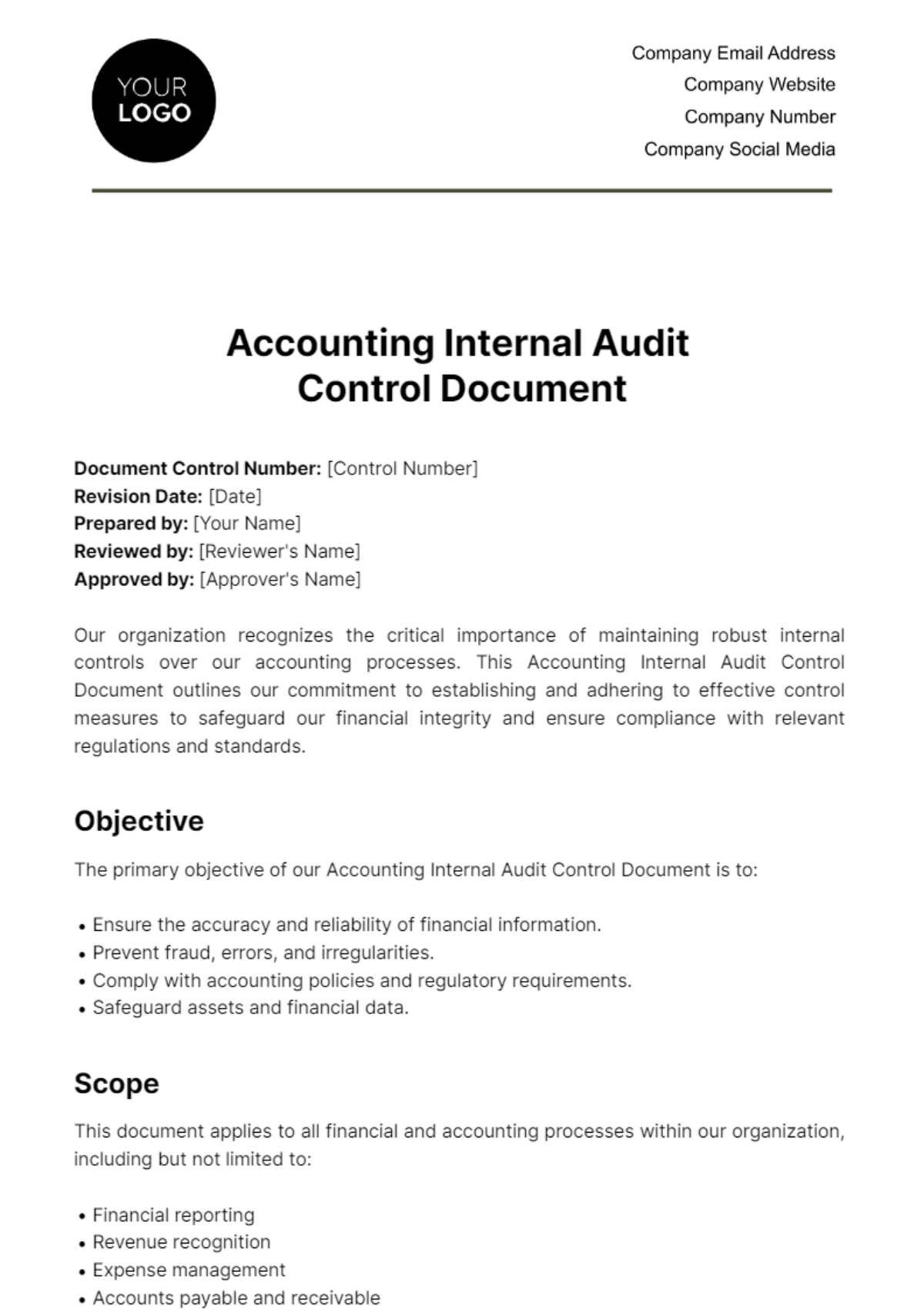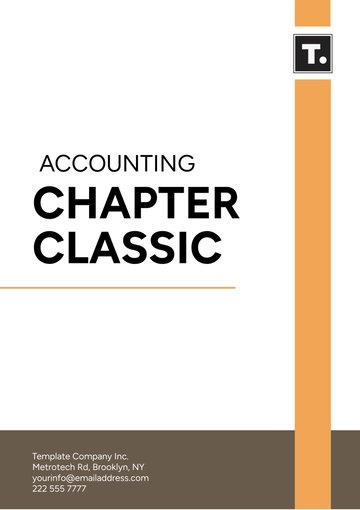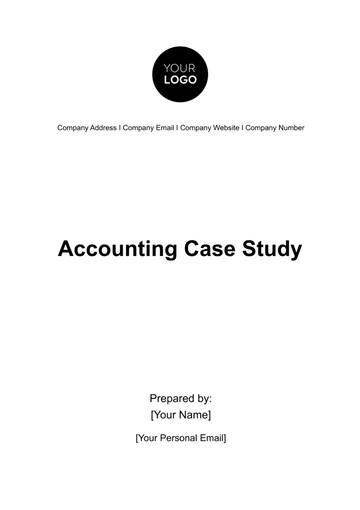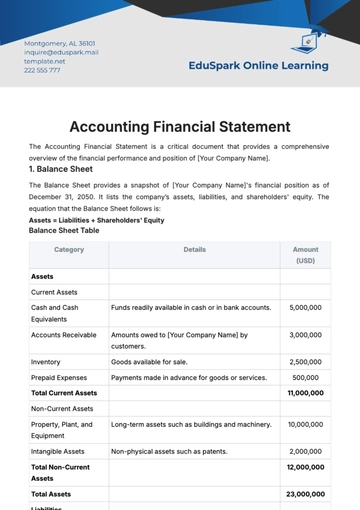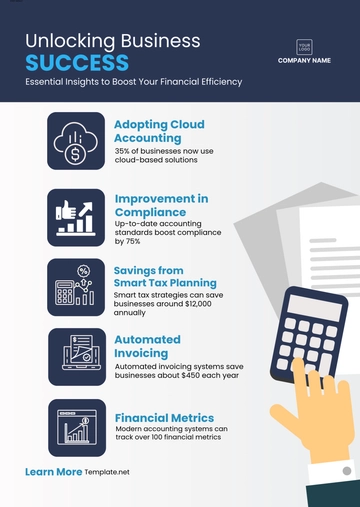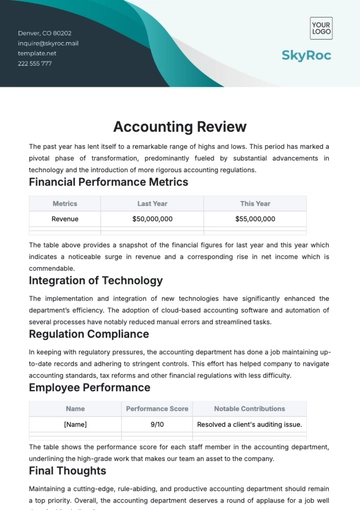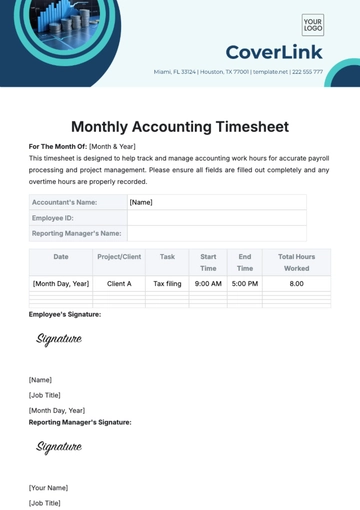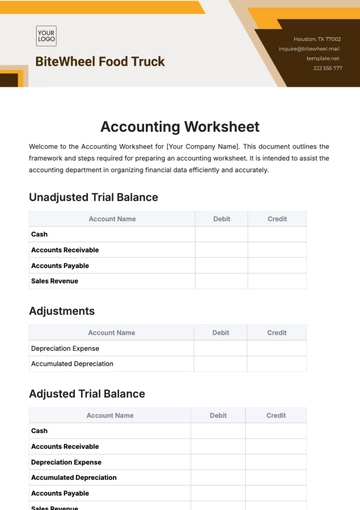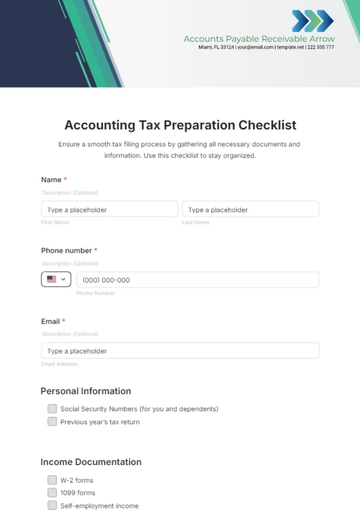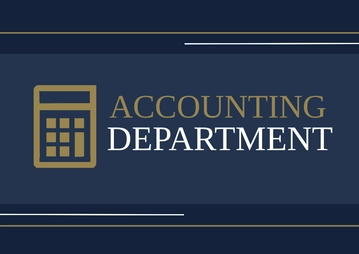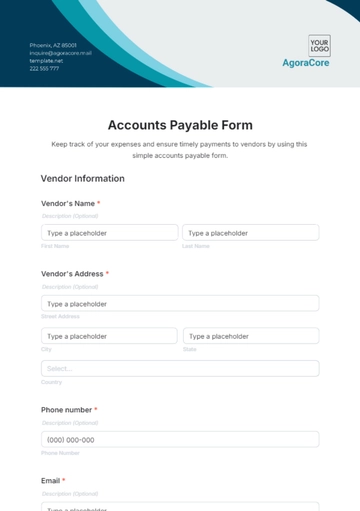Accounting Internal Audit
Control Document
Document Control Number: [Control Number]
Revision Date: [Date]
Prepared by: [Your Name]
Reviewed by: [Reviewer's Name]
Approved by: [Approver's Name]
Our organization recognizes the critical importance of maintaining robust internal controls over our accounting processes. This Accounting Internal Audit Control Document outlines our commitment to establishing and adhering to effective control measures to safeguard our financial integrity and ensure compliance with relevant regulations and standards.
Objective
The primary objective of our Accounting Internal Audit Control Document is to:
Ensure the accuracy and reliability of financial information.
Prevent fraud, errors, and irregularities.
Comply with accounting policies and regulatory requirements.
Safeguard assets and financial data.
Scope
This document applies to all financial and accounting processes within our organization, including but not limited to:
Financial reporting
Revenue recognition
Expense management
Accounts payable and receivable
Cash handling and management
Budgeting and forecasting
Internal and external audits
Responsibilities
Management: Responsible for establishing and maintaining a strong control environment, setting policies and procedures, and providing necessary resources for control implementation.
Finance Department: Responsible for adhering to control procedures, ensuring compliance with policies, and reporting any irregularities.
Internal Audit Team: Responsible for conducting periodic audits to assess the effectiveness of controls, identifying weaknesses, and making recommendations for improvements.
Control Procedures
Our control procedures encompass a wide range of activities designed to ensure the accuracy, integrity, and security of our financial processes. Below are some key control measures in place:
Control Procedure | Description |
Segregation of Duties | Critical financial tasks are separated among different personnel to prevent unauthorized or fraudulent activities. |
Access Controls | Access to financial systems and data is restricted based on job roles and responsibilities. |
Documentation and Approval | All financial transactions require proper documentation and approval in accordance with our policies. |
Reconciliation | Regular reconciliations of accounts and financial statements are conducted to identify discrepancies. |
Audit Trails | Audit trails are maintained to track and monitor changes to financial data. |
Vendor and Supplier Reviews | Vendors and suppliers are periodically reviewed to ensure compliance with contracts and agreements. |
Segregation of Duties
Identify Critical Tasks: Identify key financial tasks, such as approving transactions, recording entries, and authorizing payments, and ensure that these tasks are separated among different personnel.
Job Rotation: Implement a job rotation policy to ensure that employees do not perform the same critical tasks continuously.
Review Roles and Responsibilities: Regularly review and update job descriptions to clearly define roles and responsibilities related to financial processes.
Cross-Training: Cross-train employees to perform multiple financial tasks, ensuring that there are backup resources available for critical functions.
Access Controls
User Access Matrix: Create a user access matrix that specifies which employees have access to financial systems, databases, and files, and the level of access they have.
User Authentication: Implement strong user authentication methods, such as passwords, PINs, or biometrics, to verify the identity of individuals accessing financial systems.
Role-Based Access: Assign access privileges based on job roles and responsibilities, granting access only to the necessary financial data and applications.
Regular Access Reviews: Conduct periodic reviews of user access rights to ensure they align with job roles and responsibilities, and promptly revoke access for employees who no longer require it.
Documentation and Approval
Standardized Forms: Use standardized forms and templates for documenting financial transactions, ensuring that all necessary information is captured.
Clear Approval Hierarchy: Define a clear approval hierarchy indicating who has the authority to approve financial transactions, and ensure that approvals are documented.
Electronic Approval Workflow: Implement an electronic approval workflow system that tracks and records the approval process for financial transactions.
Record Supporting Documentation: Attach all relevant supporting documents, such as invoices, receipts, and contracts, to the transaction records.
Reconciliation
Regular Reconciliation: Establish a schedule for regular reconciliations of financial accounts, including bank accounts, general ledger accounts, and subsidiary ledgers.
Detailed Comparison: Conduct detailed comparisons between financial records and external statements, ensuring that discrepancies are promptly investigated.
Documentation of Reconciliation: Document the reconciliation process, including the individuals responsible for reconciliation, the date of reconciliation, and any issues identified.
Resolution of Discrepancies: Develop procedures for resolving discrepancies, including follow-up actions and corrections.
Audit Trails
Enable Audit Trail Features: Ensure that audit trail features are enabled in financial systems to record all changes and activities related to financial data.
Logs and Timestamps: Maintain logs with timestamps for all financial transactions and system activities, allowing for traceability.
Access to Audit Trails: Limit access to audit trails to authorized personnel only, and regularly review access logs.
Retain Audit Data: Establish a data retention policy for audit logs and ensure that they are securely stored for the required period.
Vendor and Supplier Reviews
Vendor Due Diligence: Conduct due diligence on vendors and suppliers before entering into contracts or agreements, including financial stability assessments and background checks.
Contract Compliance: Regularly review vendor contracts to ensure compliance with agreed-upon terms and conditions, including pricing, delivery schedules, and quality standards.
Performance Evaluation: Implement a vendor performance evaluation process to assess the quality of products or services provided and address any issues.
Risk Assessment: Periodically assess the risks associated with vendor relationships, including financial, operational, and reputational risks, and develop mitigation strategies.
Monitoring and Reporting
Monitoring of our control procedures is an ongoing process. Our internal audit team conducts regular reviews and assessments to identify weaknesses, areas for improvement, and compliance with controls.
Reports generated by the internal audit team are shared with management and relevant departments. Any non-compliance or findings are addressed promptly, and action plans are developed and implemented.
Documentation and Recordkeeping
We maintain comprehensive documentation of our control procedures, policies, and audit reports. These records are securely stored and are readily accessible for audit purposes.
Accounting Templates @ Template.net
